7 Soothing Yoga Poses to Calm Anxiety: A Must for Modern Lifestyles
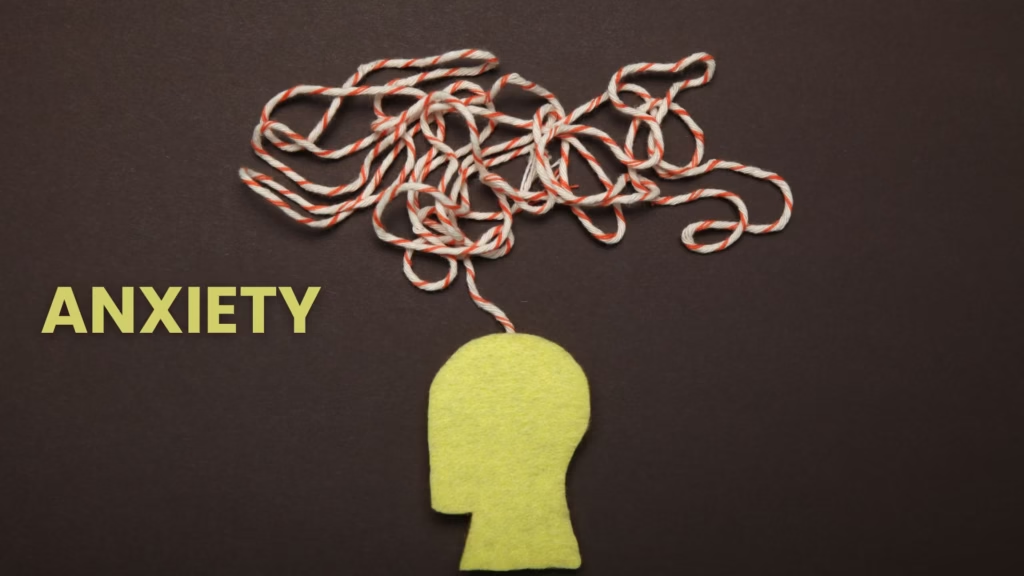
Image Credit: Canvas
In today’s fast-moving world, anxiety has become a widespread and unavoidable challenge for many individuals. With demanding schedules, social pressures, digital overload, and the sheer pace of modern living, finding inner peace can feel like an impossible task. Yoga, an ancient practice blending physical movements, breath control, and mindfulness, provides a holistic approach to counteracting stress and anxiety. In this article, we’ll explore 7 soothing yoga poses to calm anxiety, their benefits, and why they’re essential for maintaining balance in today’s demanding world.
The Importance of Yoga in Modern Life
Anxiety affects millions, showing up as restlessness, fatigue, difficulty focusing, or even physical symptoms such as tension headaches or tight muscles. Modern lifestyles can intensify these problems with sedentary behavior, poor posture, and chronic stress. Yoga serves as a natural solution [*] by:
- Reducing Stress Hormones: Yoga helps lower cortisol levels, the body’s primary stress hormone, which promotes relaxation.
- Enhancing Mindfulness: It encourages being present, which can reduce racing thoughts and emotional overwhelm.
- Easing Physical Tension: Yoga’s poses stretch and release tight muscles, especially in areas like the neck and back.
- Supporting Better Sleep: Relaxation techniques in yoga improve sleep quality, which is crucial for mental health.
Let’s dive into these yoga poses and pranayama techniques that can provide immediate and lasting relief from anxiety.
1. Nadi Shodhana (Alternate Nostril Breathing)
Why It Helps:
This breathing exercise balances the left and right hemispheres of the brain, fostering mental clarity and calmness.
Benefits:
- Reduces mental stress and emotional instability.
- Promotes focus and relaxation.
- Harmonizes the nervous system.
How to Practice:
- Sit comfortably with your spine straight.
- Use your thumb to close your right nostril and take a slow breath in through your left nostril.
- For alternate nostril breathing, gently close your left nostril with your ring finger, releasing your thumb, and exhale through your right nostril.
- Breathe in through your right nostril, then breathe out through your left.
- Repeat this cycle for 5-10 minutes.
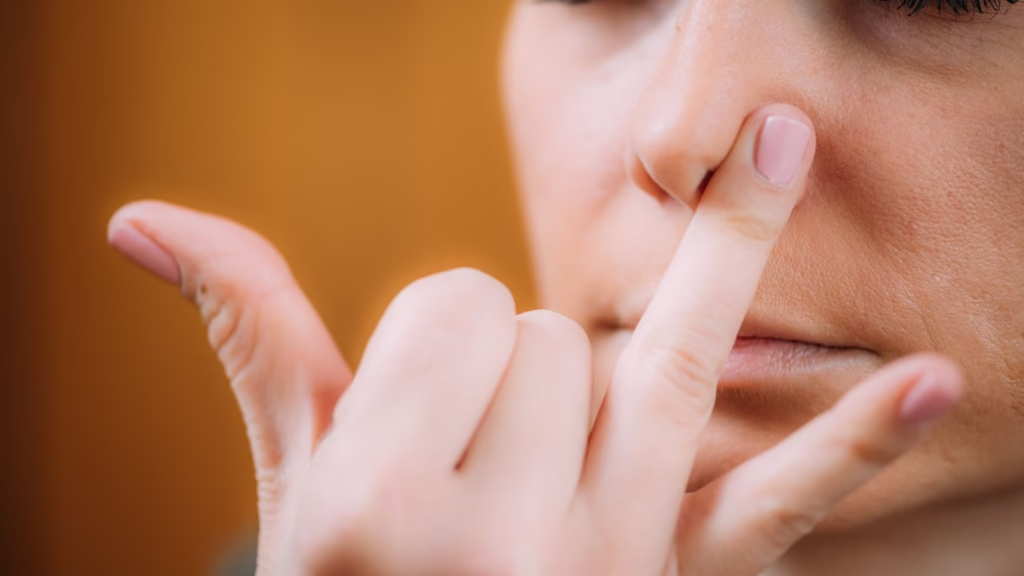
Image Credit: Canvas
2. Bhramari (Bee Breath)
Why It Helps:
Bhramari breathing creates a gentle humming sound, which helps soothe the nervous system and alleviate mental stress.
Benefits:
- Instantly calms the mind and reduces irritability.
- Lowers blood pressure naturally.
- Enhances concentration and mental clarity.
How to Practice:
- Repeat for 5-10 breaths.
- Find a calm, quiet place and gently close your eyes.
- Lightly press your index fingers against the cartilage of your ears to block external noise.
- Inhale deeply through your nose, and as you exhale, produce a gentle humming sound like a bee.
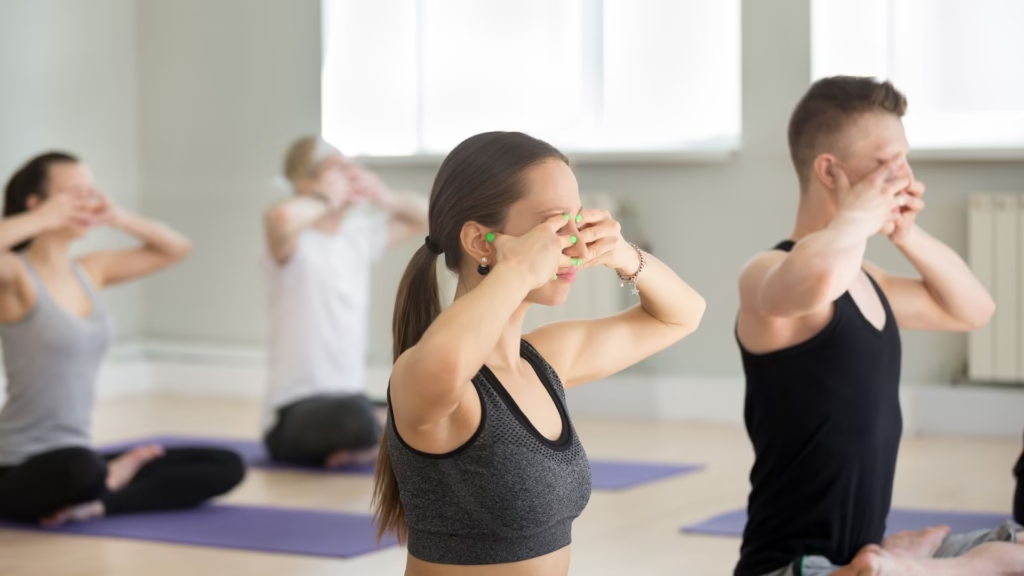
Image Credit: Canvas
3. Kapalabhati (Skull Shining Breath)
Why It Helps:
This energizing breath technique clears mental fog, detoxifies the body, and revitalizes the mind.
Benefits:
- Boosts mental clarity and energy.
- Relieves tension and uplifts mood.
- Detoxifies the lungs and improves oxygen flow.
How to Practice:
- Practice for 1-2 minutes, then rest.
- Sit comfortably with your spine straight.
- Take a deep inhale through your nose.
- Breathe out forcefully through your nose as you draw your belly inward.
- Continue with quick, forceful exhalations, allowing passive inhalations.
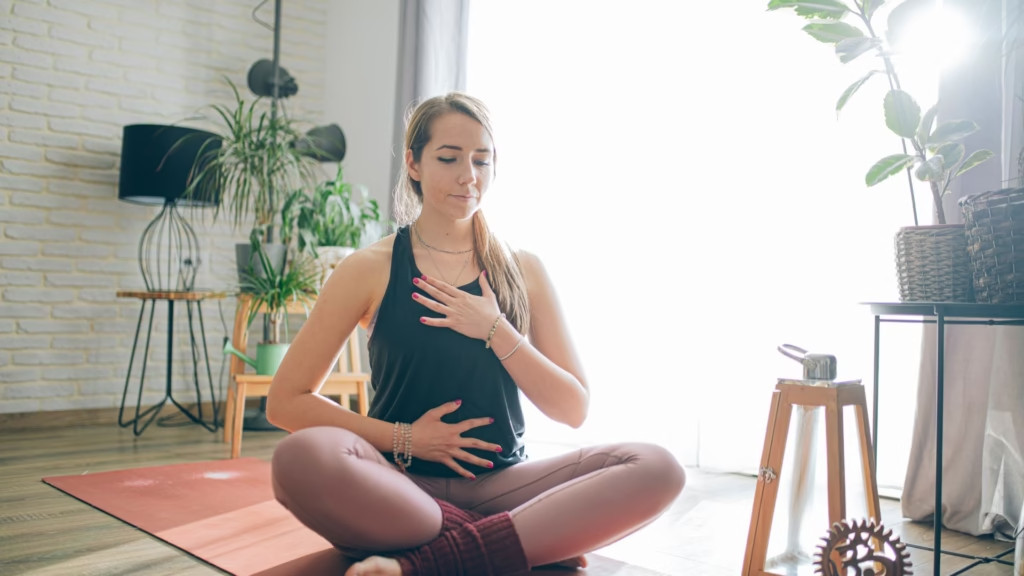
Image Credit: Canvas
4. Legs-Up-The-Wall Pose (Viparita Karani)
Why It Helps:
This restorative pose promotes relaxation by reversing blood flow and easing tension in the lower body.
Benefits:
- Relieves tired legs and lower back tension.
- Promotes deep relaxation and reduces anxiety.
- Enhances blood circulation and digestion.
How to Practice:
- Breathe deeply for 5-10 minutes.
- Position yourself sideways next to a wall, then lie back and lift your legs up to rest against the wall.
- Adjust your distance for comfort, ensuring your hips are close to the wall.
- Place your arms at your sides with palms facing upward and gently close your eyes.
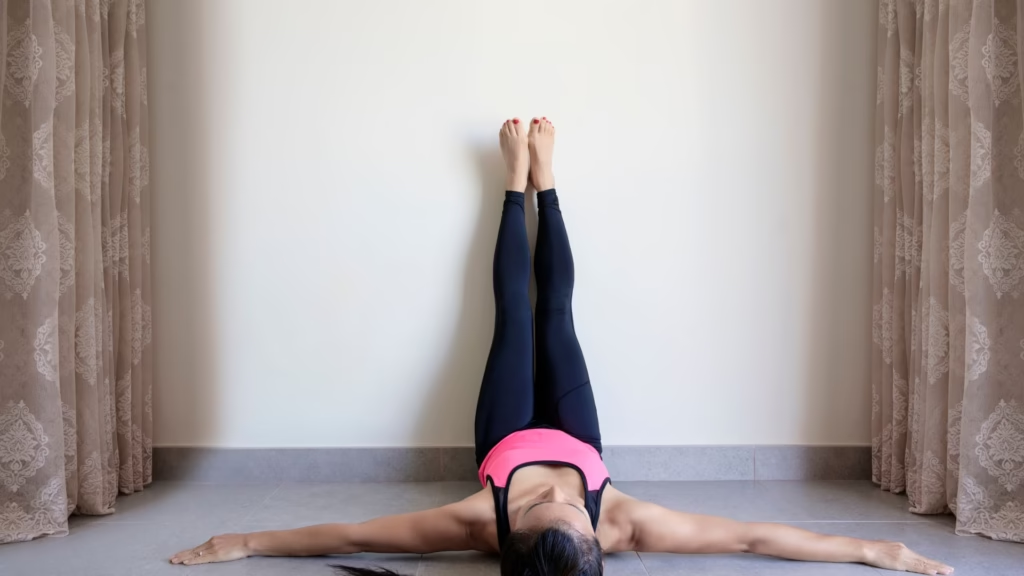
Image Credit: Canvas
5. Seated Forward Bend (Paschimottanasana)
Why It Helps:
This pose helps to relax the nervous system while stretching the spine, creating a sense of calm and mindfulness.
Benefits:
- Relieves stress and anxiety.
- Stretches the back, shoulders, and hamstrings.
- Encourages introspection and inner peace.
How to Practice:
- Sit with your legs extended straight ahead.
- Breathe in to elongate your spine, then breathe out as you bend forward from your hips.
- To practice a forward stretch, reach for your feet or shins while keeping your back extended and long.
- Hold the position for 5-10 breaths, allowing yourself to relax more deeply with each inhale and exhale.
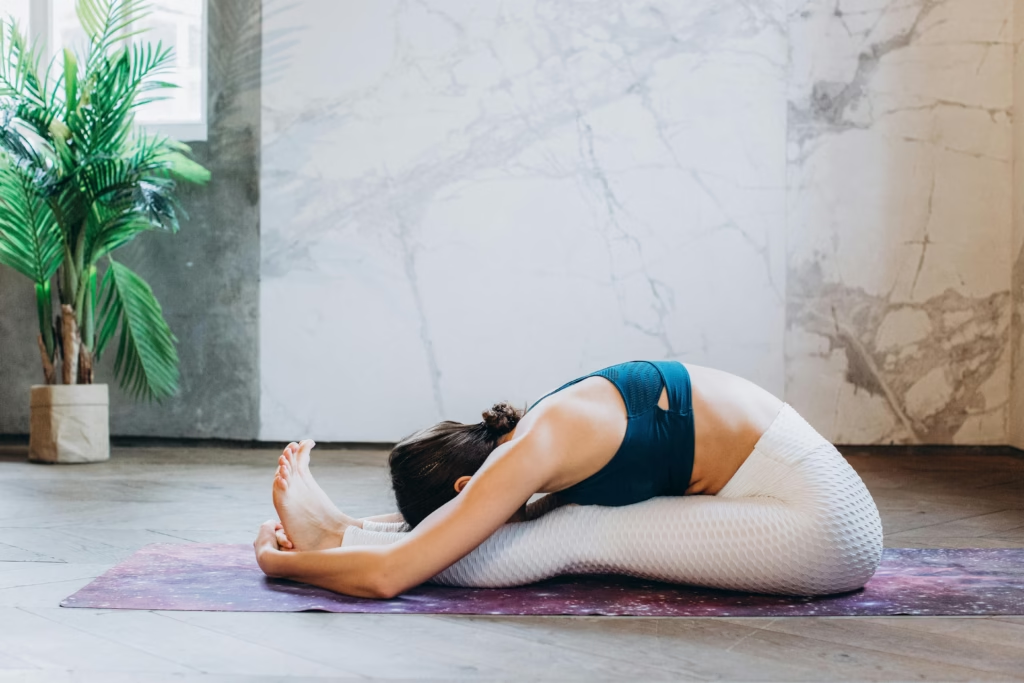
Image Credit: Canvas
6. Bridge Pose (Setu Bandhasana)
Why It Helps:
Bridge Pose is great for improving posture, opening the chest, and stimulating the body’s relaxation response.
Benefits:
- Relieves stress and fatigue.
- Opens the chest and heart space.
- Boosts energy and circulation.
How to Practice:
- Lie on your back with your knees bent and your feet placed about hip-width apart.
- Press into your feet and lift your hips, rolling your shoulders underneath for support.
- Hold for 5-8 breaths, then lower slowly.
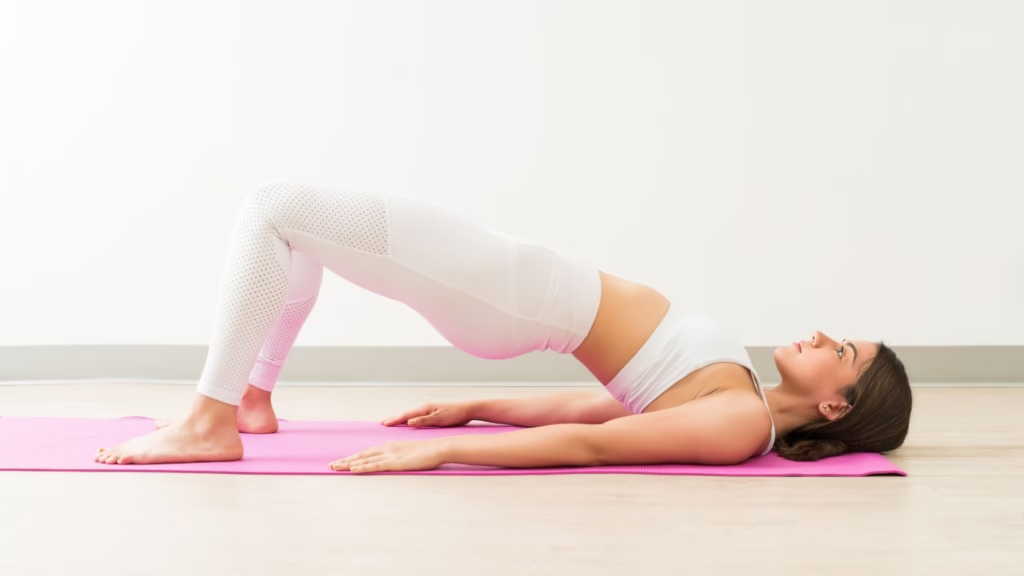
Image Credit: Canvas
7. Corpse Pose (Savasana)
Why It Helps:
Savasana, often called the ultimate relaxation pose, helps you fully absorb the benefits of your yoga practice and calm your nervous system.
Benefits:
- Provides deep relaxation and stress relief.
- Encourages mindfulness and awareness.
- Restores balance to the body and mind.
How to Practice:
- Lie flat on your back with your arms resting at your sides and palms facing up.
- Close your eyes and focus on natural, deep breathing.
- Stay in this pose for 5-10 minutes, letting go of tension with each exhale.
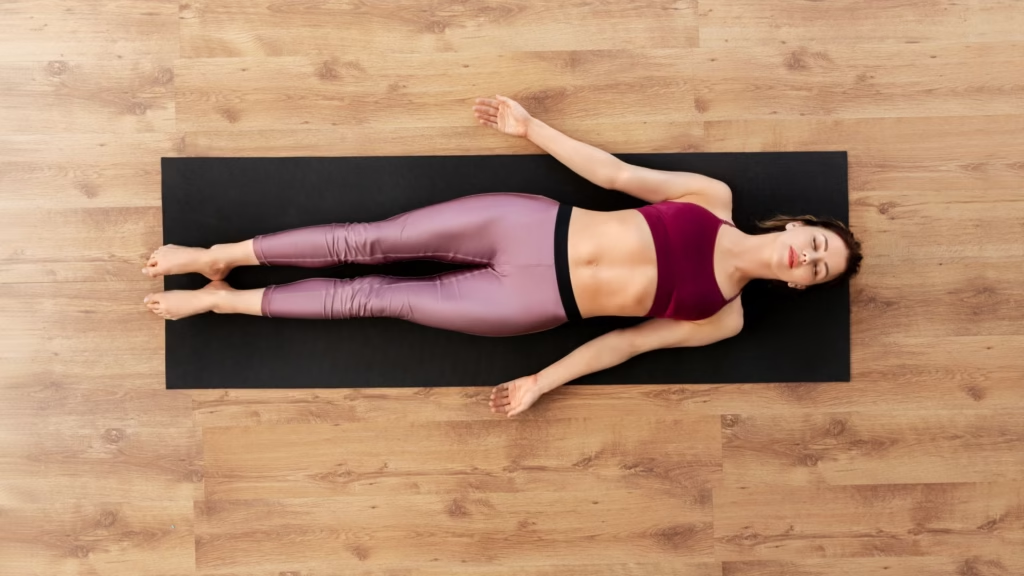
Image Credit: Canvas
Clinical Evidence Supporting Yoga for Anxiety Relief
Recent studies have increasingly shown evidence that yoga can be effective in reducing symptoms of anxiety.
- NYU Langone Health Study: A study by researchers at NYU Grossman School of Medicine found that yoga worked better than regular stress management education for generalized anxiety disorder. While cognitive behavioral therapy (CBT) showed better results, yoga remains a useful choice for people seeking alternative or extra treatment options. Patient Care at NYU Langone Health
- Systematic Review and Meta-Analysis: A systematic review and meta-analysis published in Depression and Anxiety examined multiple studies on yoga’s impact on anxiety disorders. The review concluded that while there is preliminary evidence supporting yoga’s effectiveness in reducing anxiety symptoms, more high-quality studies are needed to confirm these findings. Pubmed
Final Thoughts
Incorporating these 7 soothing yoga poses to calm anxiety into your daily routine can profoundly impact your physical and mental health. These practices not only bring immediate relief but also build resilience against future stress. By setting aside time for yoga and mindfulness, you empower yourself to handle life’s challenges with calm and clarity.
Start with just a few minutes each day, and let yoga guide you toward a more balanced, peaceful state of being.
Disclaimer:
This article is for information purpose only. Before starting any new exercise program, including yoga, consult with a healthcare provider, especially if you have any existing health issues or concerns.
Yoga can promote overall wellness and help with managing anxiety, but results can vary from person to person. If any pose causes discomfort or pain, stop immediately and consult a doctor if needed. It is best to practice yoga with a certified instructor to ensure proper technique and safety. Your well-being is the top priority! 🩺💛
